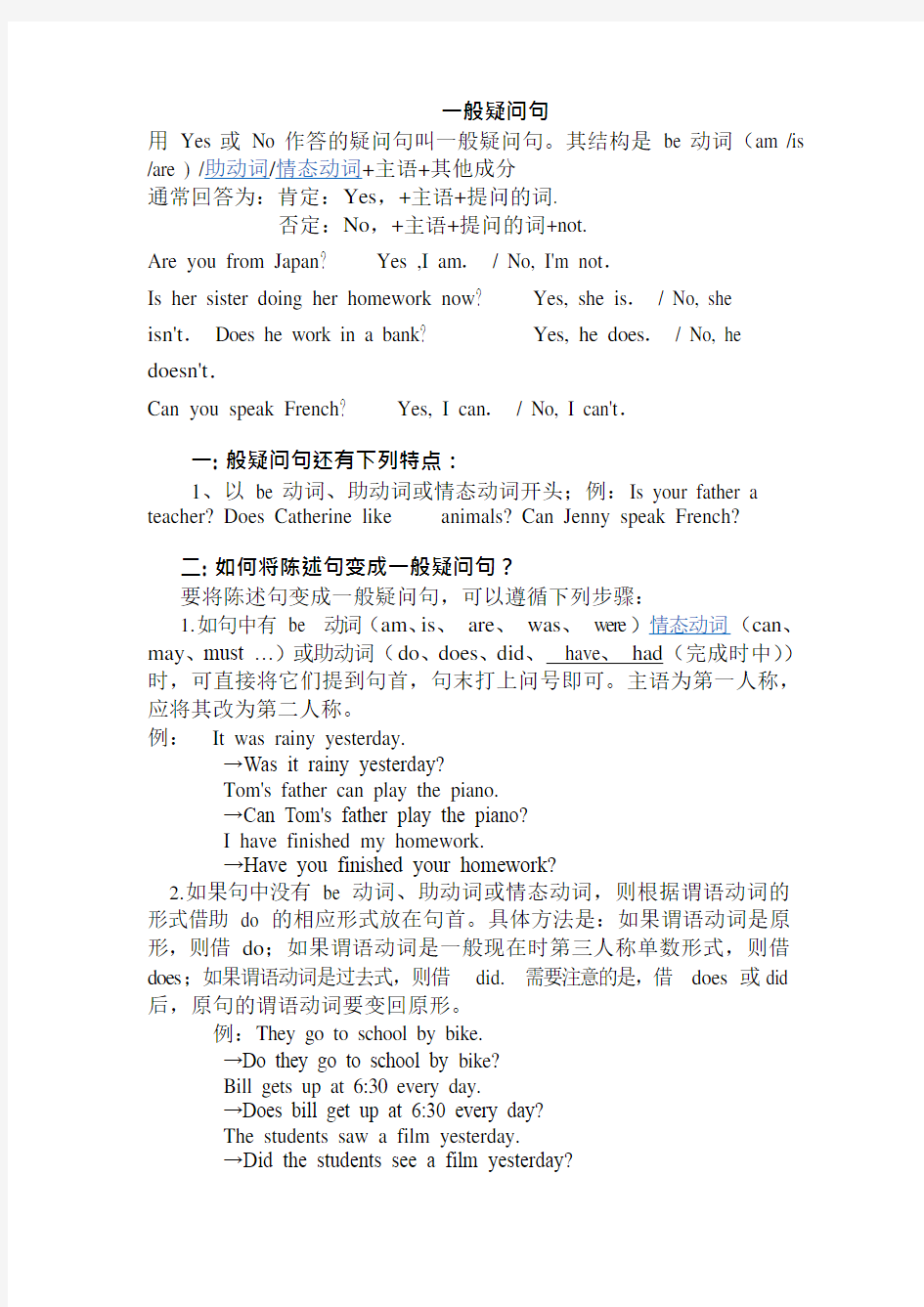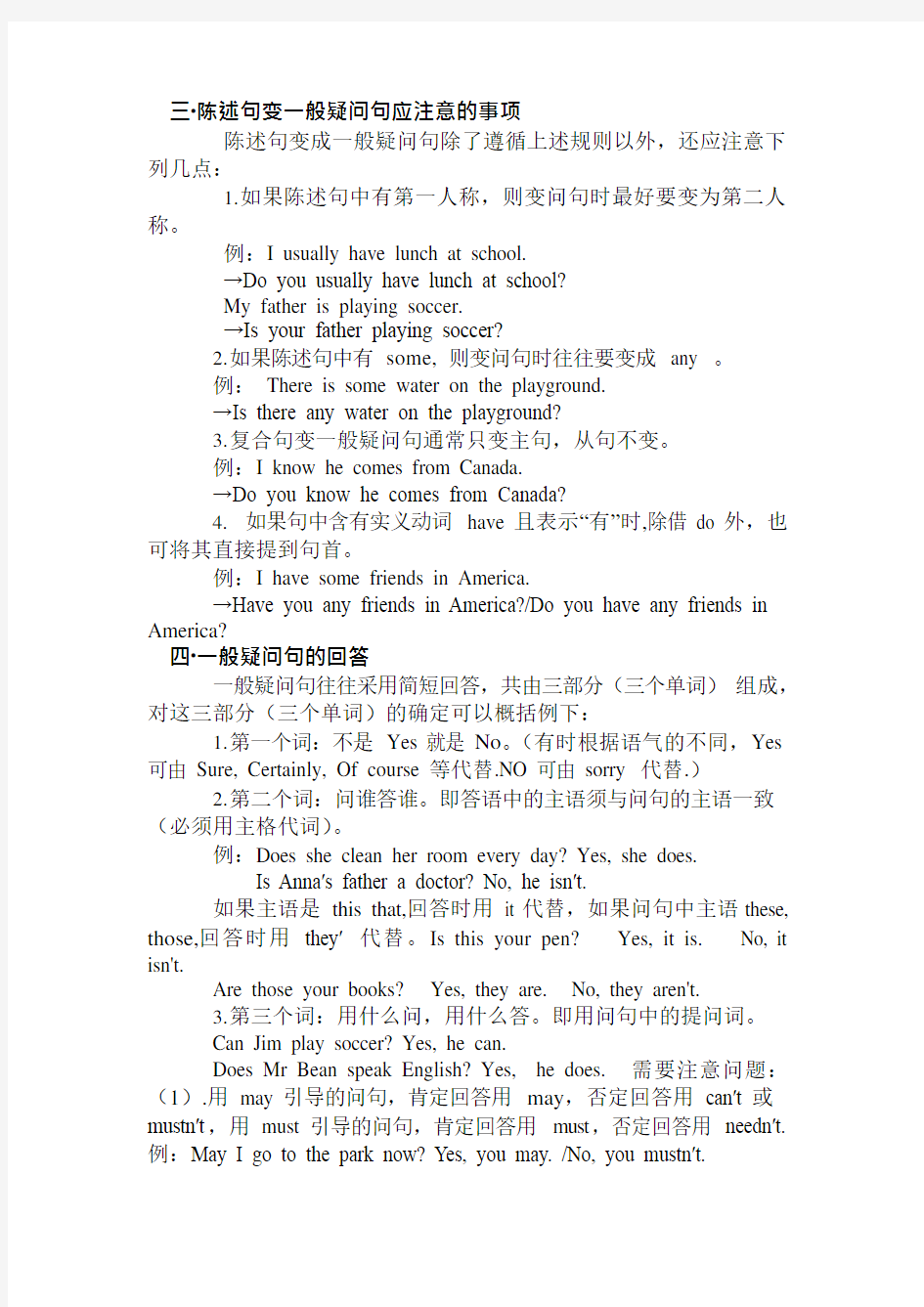(完整版)英语一般疑问句和特殊疑问句的讲解及练习(最新整理)


一般疑问句
用Yes 或No 作答的疑问句叫一般疑问句。其结构是be 动词(am /is /are ) /助动词/情态动词+主语+其他成分
通常回答为:肯定:Yes,+主语+提问的词.
否定:No,+主语+提问的词+not.
Are you from Japan﹖Yes ,I am./ No, I'm not.
Is her sister doing her homework now﹖Yes, she is./ No, she
isn't.Does he work in a bank﹖Yes, he does./ No, he doesn't.
Can you speak French﹖Yes, I can./ No, I can't.
一: 般疑问句还有下列特点:
1、以be 动词、助动词或情态动词开头;例:Is your father a teacher? Does Catherine like animals? Can Jenny speak French?
二: 如何将陈述句变成一般疑问句?
要将陈述句变成一般疑问句,可以遵循下列步骤:
1.如句中有be 动词(am、is、are、was、were)情态动词(can、may、must …)或助动词(do、does、did、 have、had(完成时中))时,可直接将它们提到句首,句末打上问号即可。主语为第一人称,应将其改为第二人称。
例:It was rainy yesterday.
→Was it rainy yesterday?
Tom's father can play the piano.
→Can Tom's father play the piano?
I have finished my homework.
→Have you finished your homework?
2.如果句中没有be 动词、助动词或情态动词,则根据谓语动词的形式借助do 的相应形式放在句首。具体方法是:如果谓语动词是原形,则借do;如果谓语动词是一般现在时第三人称单数形式,则借does;如果谓语动词是过去式,则借did. 需要注意的是,借does 或did 后,原句的谓语动词要变回原形。
例:They go to school by bike.
→Do they go to school by bike?
Bill gets up at 6:30 every day.
→Does bill get up at 6:30 every day?
The students saw a film yesterday.
→Did the students see a film yesterday?
三.陈述句变一般疑问句应注意的事项
陈述句变成一般疑问句除了遵循上述规则以外,还应注意下列几点:
1.如果陈述句中有第一人称,则变问句时最好要变为第二人称。
例:I usually have lunch at school.
→Do you usually have lunch at school?
My father is playing soccer.
→Is your father playing soccer?
2.如果陈述句中有some, 则变问句时往往要变成any 。
例:There is some water on the playground.
→Is there any water on the playground?
3.复合句变一般疑问句通常只变主句,从句不变。
例:I know he comes from Canada.
→Do you know he comes from Canada?
4.如果句中含有实义动词have 且表示“有”时,除借do 外,也可将其直接提到句首。
例:I have some friends in America.
→Have you any friends in America?/Do you have any friends in America?
四.一般疑问句的回答
一般疑问句往往采用简短回答,共由三部分(三个单词)组成,对这三部分(三个单词)的确定可以概括例下:
1.第一个词:不是Yes 就是No。(有时根据语气的不同,Yes 可由Sure, Certainly, Of course 等代替.NO 可由sorry 代替.)
2.第二个词:问谁答谁。即答语中的主语须与问句的主语一致(必须用主格代词)。
例:Does she clean her room every day? Yes, she does.
Is Anna′s father a doctor? No, he isn′t.
如果主语是this that,回答时用it 代替,如果问句中主语these, those,回答时用they′ 代替。Is this your pen? Yes, it is. No, it isn't.
Are those your books? Yes, they are. No, they aren't.
3.第三个词:用什么问,用什么答。即用问句中的提问词。
Can Jim play soccer? Yes, he can.
Does Mr Bean speak English? Yes, he does. 需要注意问题:(1).用may 引导的问句,肯定回答用may,否定回答用can′t 或mustn′t,用must 引导的问句,肯定回答用must,否定回答用needn′t. 例:May I go to the park now? Yes, you may. /No, you mustn′t.
Must I wash my clothes now? Yes, you must. /No, you needn′t.
4.作否定回答时,结尾要加上not。否定回答最好缩写,而肯
定回答不能缩写。
例:Did Thomas come here yesterday? Yes, he did./ No ,he didn′t.
Is Lin Lin in Class 3? Yes, she is. / No, she isn′t.或(No, she′s not).
特殊疑问句
以疑问词开头,对句中某一成分提问的句子叫特殊疑问句。常用
的疑问词有:what(什么),who(谁),whose(谁的),which (哪个),when(何时),where(哪里),how(怎样,通过...),why(为何)等。
特殊疑问句有两种语序:
1.如疑问词作主语或主语的定语,即对主语或主语的定语提问,其语序是陈述句的语序:疑问词(+主语)+谓语动词+其他成分?如:who is singing in the room﹖
whose bike is broken﹖
2.如疑问词作其他成分,即对其他成分提问,其语序是:疑问词+一般疑问句语序?如:
what class are you in﹖
What does she look like﹖
Where are you from﹖
What time does he get up every morning﹖
How do you know﹖
特殊疑问词+助动词+主语+动词原形+其他?
eg:Where do you do study English?
特殊疑问词+be 动词+主语+其他?
eg:Why is your Mum so angry?
特殊疑问词+情态动词+主语+动词原形+其他?
eg:What can I do for you?
注意:
1.回答特殊疑问句时,不能用yes /no,即问什么答什么,尤其是
简略回答。如:
Who is from Canada﹖
Helen (is).
